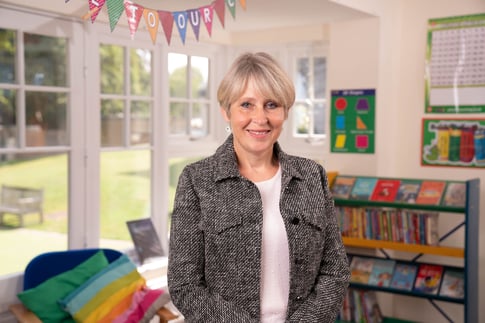Headteacher’s Blog: Why the junior years matter in girls’ education
Headteacher's Blog: Why we love iPads - 10 years of Digital Learning at Redmaids' High Junior School

Ten years ago, we took a great leap of faith, as one of the first schools in Bristol to begin using iPads in the classroom and we have never looked back! Today, they are an integral part of school kit with every Junior pupil having a 1:1 device at their fingertips. The real world uses technology readily and so why shouldn’t school too? Most work environments will have phones, PCs, laptops or tablets at the very least and we are preparing your children for the future. Educating your child includes integrating technology as a natural part of everyday life, using it wisely. Don’t worry though, as handwriting is still a top priority and books remain highly valued.
An iPad is part of everyone's pencil case at Redmaids' High Junior School. As the Swiss Army Knife of digital learning tools, an iPad does it all: it is a camera, a voice recorder, a keyboard, a search engine, a paintbox, a musical instrument, a spelling test, a film-maker, an organiser and, as our girls will tell you, much more. Indeed, much debate ensues about the favourite apps and learning support they offer amongst the girls. The children are knowledgeable and recognise the benefits of the tools at their fingertips. Keynote is a firm favourite but it can be rivalled by other choices. When we started, lessons took much longer as we embedded the IT skills needed to utilise the technology, but now the children whizz through introductions using the apps instinctively.
When girls join the school, from Year 3 onwards, they are loaned an iPad, in the same way as they might take out a library book. It is school property for 1:1 use at school and home. There is no extra cost incurred. At first, a great novelty, they quickly learn that it is a learning tool and they reap the benefits.
The school iPads are enabled with apps specific to learning across a wide range of skills and subjects, from spelling tests, to music composition, to computer science. Typically, expect to take home DoodleMaths, Procreate, Brushes, PicCollage, Google Earth, iMovie, Garageband, Popplet, LEGO Robotics, ScratchJr, Sphero Edu, iFunFace, Spelling Shed and Kahoot. Imagine packing all this into your school bag in any other way! The list of available apps is continually updated, following requests from teachers, who are always on the look-out for new mind-bending, eye-popping, subject-specific digital platforms. Screen sharing and mirroring offer multiple opportunities for collaborative tasks in the classroom. Through Firefly, our virtual learning platform, known as The Hub, teachers set tasks and give feedback in an easily accessible way.
So what have the iPads brought to the classrooms? Variety, fun, engagement and accessible learning are just a few examples. Every child is unique and iPads offer different learning pathways and memorable tasks. Pupils and teachers can decide to organise and present opinions and information in a variety of ways, using different apps to zone in on individual learning styles and preferences. Recording yourself on iFunface as John Cabot is an enjoyable way to explore history, recalling facts and information without realizing how hard they are working. Science experiments can be filmed and voice notes added. Photographs can detail changes. Indeed, humanities and science lend themselves to Book Creator and collaborative Keynotes where teachers and pupils work on slides together. For those needing some support, Mrs Grace Wakelin, our SENCO, advocates the iPads for voice memos which can be hugely advantageous, as can a well-set reminder, as we all know.
For parents, the benefits of iPads are that part of school comes home. You can share the iPad with your child, view their work and get involved. Parents have access to the school Hub too, where you can access your child’s tasks, timetable, homework, sports, daily menus, trip information and Friday Bulletins from your own device.
Of course, E-safety is taken very seriously. Girls are taught to use technology safely, efficiently and respectfully, enabling them to develop digital literacy and operational skills. Recognising healthy digital habits, and considering online truth and safety, are embedded into our pastoral care. We even had a digital detox recently over a weekend; getting out and about in the outside is a key ethos of our school too. For reassurance, the school iPads disable the use of iMessage, Facetime, all social media and the app store. Only apps requested by teachers become accessible to pupils and, on site, education level Smoothwall filtering is enabled.
This is only possible if you have an adventurous, dedicated and engaged teaching team who use the technology in the classrooms to their best effect. Ask the girls here how they are used, come and see the efficiency in which they are handled and watch the children screen sharing an example of their work to discuss with their peers. Seeing it in action and using it quickly demonstrates the benefits. We haven’t looked back, but we know that we need to keep moving forward.
I warmly invite you to come and visit the Junior School to see it for yourselves.



-3.jpg?width=770&name=Untitled%20design%20(1)-3.jpg)
.png?width=770&name=Untitled%20design%20(87).png)


.jpg?width=770&name=20231012_085836%20(1).jpg)







%20(1).png?width=770&name=Copy%20of%20Languages%20postcard%20version%202%20(620%20x%20620%20px)%20(1).png)
.jpeg?width=770&name=image00002%20(1).jpeg)




